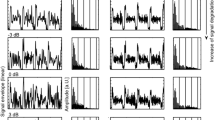Summary
In the two acridid speciesChorthippus parallelus andCh. montanus, the sound template by which females recognize male song varies with temperature, as does the song itself. At relatively high temperatures the females respond best to simulated songs with high syllable frequencies, and at lower temperatures songs with lower syllable frequencies are preferred.
The temperature around the supraesophageal and metathoracic ganglia of female grasshoppers was monitored by implanted thermocouples, and either the head or the thorax was warmed selectively while the animal was free to move (within the imits of the wires). Then simulations of the conspecific song varying in syllable frequency corresponding to different song temperatures were presented, and the stridulatory responses of the animals were observed.
The results were as follows. 1. Song recognition (in particular, the position of the peak of the response curve) depended on the temperature of the head. 2. The rate of stridulatory hindleg movement was determined by the temperature of the thoracic ganglia.
This result provides strong evidence against the genetic coupling hypothesis.
Similar content being viewed by others
References
Abrams TW, Pearson KG (1982) Effects of temperature on identified central neurons that control jumping in the grasshopper. J Neurosci 2:1538–1553
Boyan GS (1980) Auditory neurones in the brain of the cricketGryllus bimaculatus (De Geer). J Comp Physiol 140:81–93
Doherty JA (1985) Temperature coupling and ‘trade-off’ phenomena in the acoustic communication system of the cricketGryllus bimaculatus. J Exp Biol 114:17–35
Doherty J, Hoy R (1985) Communication in insects. III. The auditory behavior of crickets: Some views of genetic coupling, song recognition, and predator detection. Q Rev Biol 60:457–472
Elsner N, Huber F (1969) Die Organisation des Werbegesangs der HeuschreckeGomphocerippus rufus in Abhängigkeit von zentralen und peripheren Bedingungen. Z Vergl Physiol 65:389–423
Fischer L, Florey E (1981) Temperature effects on neuromuscular transmission (opener muscle of crayfish,Astacus leptodactylus). J Exp Biol 94:251–268
Hedwig B (1986) On the role in stridulation of plurisegmental interneurons of the acridid grasshopperOmocestus viridulus. J Comp Physiol A 158:413–427
Helversen D von (1972) Gesang des Männchens und Lautschema des Weibchens bei der FeldheuschreckeChorthippus biguttulus (Orthoptera, Acrididae). J Comp Physiol 81:381–422
Helversen D von, Helversen O von (1981) Korrespondenz zwischen Gesang und auslösendem Schema bei Feldheuschrekken. Nova Acta Leopold NF 54 Nr. 245:449–462
Helversen O von (1979) Angeborenes Erkennen akustischer Schlüsselreize. Verh Dtsch Zool Ges 1979:42–59
Kutsch W, Otto D (1972) Evidence for spontaneous song production independent of head ganglia inGryllus campestris. J Comp Physiol 81:115–119
Ronacher B, Helversen D von, Helversen O von (1986) Routes and stations in the processing of auditory directional information in the CNS of a grasshopper, as revealed by surgical experiments. J Comp Physiol A 158:363–374
Schildberger K (1984) Temporal selectivity of identified auditory neurons in the cricket brain. J Comp Physiol A 155:171–185
Walker TJ (1957) Specificity in the responses of female tree crickets (Orthoptera, Gryllidae, Oecanthinae) to calling songs of the males. Ann Entomol Soc Am 50:626–636
Walker TJ (1975) Effects of temperature on rates in poikilotherm nervous systems: Evidence from the calling songs of meadow katydids (Orthoptera: Tettigoniidae: Orchelimum) and reanalysis of published data. J Comp Physiol 101:57–69
Author information
Authors and Affiliations
Rights and permissions
About this article
Cite this article
Bauer, M., von Helversen, O. Separate localization of sound recognizing and sound producing neural mechanisms in a grasshopper. J. Comp. Physiol. 161, 95–101 (1987). https://doi.org/10.1007/BF00609458
Accepted:
Issue Date:
DOI: https://doi.org/10.1007/BF00609458




